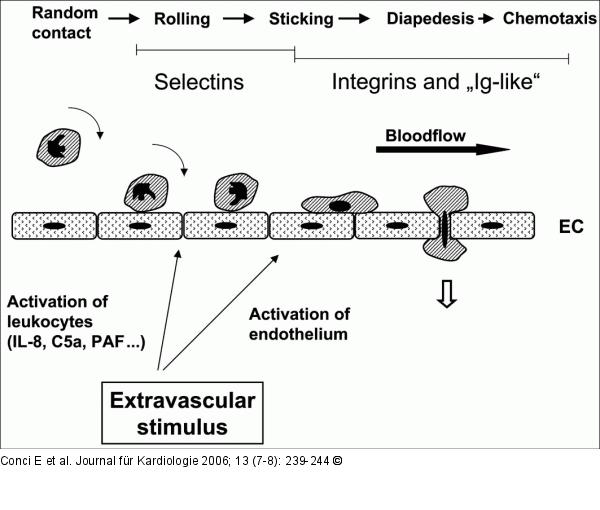Conci E, Pachinger O, Metzler B Mouse Models for Myocardial Ischaemia/Reperfusion Journal für Kardiologie - Austrian Journal of Cardiology 2006; 13 (7-8): 239-244 Volltext (PDF) Summary Übersicht
| ||||||
Abbildung 1: Adhesion Molecules Scheme of involvement of the adhesion molecules in ischaemia/reperfusion. Under normal conditions, there are virtually no interactions between the endothelium and neutrophils. After coronary ischaemia/reperfusion, the blood vessel’s ability to form NO is severely reduced. With decreased supplies of NO, the coronary vessel may constrict. Additional adhesion molecules were expressed on the endothelium and polymorphonuclear leukocytes (PMNs) begin with rolling as the first step in PMN sequestration. As the PMN slows, tighter interactions between CD18 (on PMN) and ICAM-1 (on endothelium) cause the second phase of the PMN-EC interaction called sticking. The final step, the diapedesis, involves the coordination of many factors. |

Abbildung 1: Adhesion Molecules
Scheme of involvement of the adhesion molecules in ischaemia/reperfusion. Under normal conditions, there are virtually no interactions between the endothelium and neutrophils. After coronary ischaemia/reperfusion, the blood vessel’s ability to form NO is severely reduced. With decreased supplies of NO, the coronary vessel may constrict. Additional adhesion molecules were expressed on the endothelium and polymorphonuclear leukocytes (PMNs) begin with rolling as the first step in PMN sequestration. As the PMN slows, tighter interactions between CD18 (on PMN) and ICAM-1 (on endothelium) cause the second phase of the PMN-EC interaction called sticking. The final step, the diapedesis, involves the coordination of many factors. |



